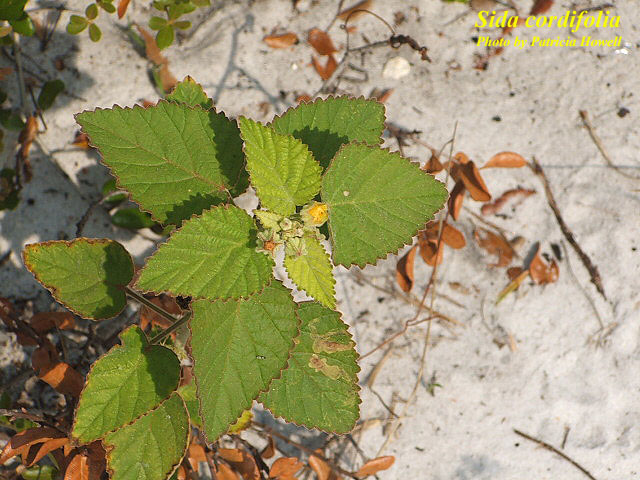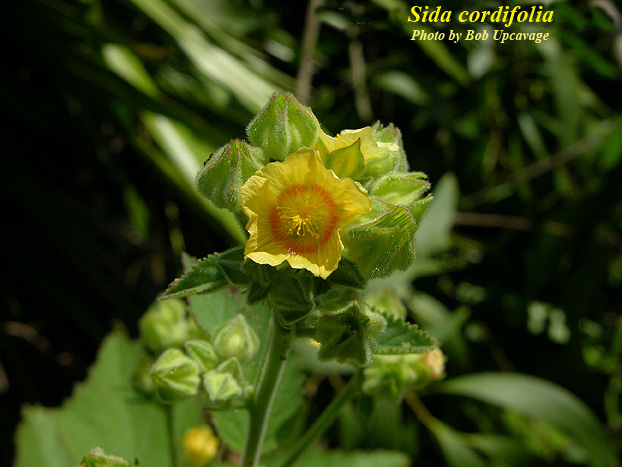Difference between revisions of "Sida cordifolia"
(→Description) |
HaleighJoM (talk | contribs) (→Ecology) |
||
| (27 intermediate revisions by 8 users not shown) | |||
| Line 3: | Line 3: | ||
{{taxobox | {{taxobox | ||
| name = Sida cordifolia | | name = Sida cordifolia | ||
| − | | image = | + | | image = Sida_cord.jpg |
| − | | image_caption = | + | | image_caption = Photo by Patricia Howell, [http://www.florida.plantatlas.usf.edu/Default.aspx Atlas of Florida Vascular Plants] |
| regnum = Plantae | | regnum = Plantae | ||
| divisio = Magnoliophyta - Flowering plants | | divisio = Magnoliophyta - Flowering plants | ||
| Line 15: | Line 15: | ||
| binomial_authority = L. | | binomial_authority = L. | ||
| range_map = sida_cord_dist.jpg | | range_map = sida_cord_dist.jpg | ||
| − | | range_map_caption = Natural range of ''Sida cordifolia'' from USDA NRCS [http:// | + | | range_map_caption = Natural range of ''Sida cordifolia'' from USDA NRCS [http://plants.usda.gov/core/profile?symbol=SICO Plants Database]. |
}} | }} | ||
| + | |||
| + | Common names: ‘Ilima, Great-leaved sida | ||
| + | ==Taxonomic notes== | ||
==Description== | ==Description== | ||
<!-- Basic life history facts such as annual/perrenial, monoecious/dioecious, root morphology, seed type, etc. --> | <!-- Basic life history facts such as annual/perrenial, monoecious/dioecious, root morphology, seed type, etc. --> | ||
| − | + | ''S. cordifolia'' is a shrub that grows up to 1.5 meters tall. Leaves are heart shaped, serrate and truncate. Flowers are small, yellow or white, solitary and axillaries. Seeds are grayish black and smooth.<ref name="japsonline">[[http://japsonline.com/admin/php/uploads/16_pdf.pdf]]Accessed: March 15, 2016</ref> | |
==Distribution== | ==Distribution== | ||
| + | It is a Native of India, however, it is also found in Florida, Alabama, and Texas.<ref name="japsonline"/> | ||
| + | |||
==Ecology== | ==Ecology== | ||
===Habitat=== <!--Natural communities, human disturbed habitats, topography, hydrology, soils, light, fire regime requirements for removal of competition, etc.--> | ===Habitat=== <!--Natural communities, human disturbed habitats, topography, hydrology, soils, light, fire regime requirements for removal of competition, etc.--> | ||
| + | Grows in damp climates and in waste areas.<ref name="japsonline"/> | ||
===Phenology=== <!--Timing off flowering, fruiting, seed dispersal, and environmental triggers. Cite PanFlora website if appropriate: http://www.gilnelson.com/PanFlora/ --> | ===Phenology=== <!--Timing off flowering, fruiting, seed dispersal, and environmental triggers. Cite PanFlora website if appropriate: http://www.gilnelson.com/PanFlora/ --> | ||
| − | ===Seed dispersal=== | + | Flowers from August to December, fruits October to January.<ref name="japsonline"/> |
| − | ===Seed bank and germination=== | + | <!--===Seed dispersal===--> |
| − | ===Fire ecology=== <!--Fire tolerance, fire dependence, adaptive fire responses--> | + | <!--===Seed bank and germination===--> |
| + | <!--===Fire ecology===--> <!--Fire tolerance, fire dependence, adaptive fire responses--> | ||
===Pollination=== | ===Pollination=== | ||
| − | + | ''Sida cordifolia'' has been observed at the Archbold Biological Station with bees such as ''Apis mellifera'' (family Apidae), sweat bees from the Halictidae family such as ''Agapostemon splendens, Augochloropsis metallica, Lasioglossum pectoralis, L. placidensis'' and ''L. tamiamensis'', leafcutting bees from the Megachilidae family such as ''Anthidiellum notatum rufomaculatum, Anthidium maculifrons, Coelioxys mexicana, Megachile albitarsis'' and ''M. texana'', and spider wasps such as ''Ageniella faceta ventralis'' (family Pompilidae).<ref name="Deyrup 2015">Deyrup, M.A. and N.D. 2015. Database of observations of Hymenoptera visitations to flowers of plants on Archbold Biological Station, Florida, USA.</ref> | |
| + | <!--===Herbivory and toxicology===<!--Common herbivores, granivory, insect hosting, poisonous chemicals, allelopathy, etc--> | ||
| + | <!--===Diseases and parasites===--> | ||
| − | + | ==Conservation, cultivation, and restoration== | |
| − | + | ==Cultural use== | |
| + | ''S. cordifolia'' is highly recognized for its medicinal properties: it contains ephedrine, vasicinol, vasicinone, and N-methyl tryptophan. Traditional medicine has used it to treat chronic dysentery, and asthma.<ref name="sivanesan">Sivanesan, I. and B. R. Jeong (2007). "Direct Shoot Regeneration from Nodal Explants of Sida Cordifolia Linn." In Vitro Cellular & Developmental Biology. Plant 43(5): 436-441.</ref> | ||
| − | + | ==Photo Gallery== | |
| + | <gallery widths=180px> | ||
| + | File: Sida_cord_BUpcavage.jpg | <center> Flowers of ''Sida'' ''cordifolia'' <p> Photo by Bob Upcavage, [http://www.florida.plantatlas.usf.edu/Default.aspx Atlas of Florida Vascular Plants] </p> | ||
| + | </gallery> | ||
| − | |||
| − | |||
| − | |||
| − | |||
| − | |||
| − | |||
| − | |||
| − | |||
| − | |||
| − | |||
| − | |||
| − | |||
| − | |||
| − | |||
| − | |||
| − | |||
| − | |||
| − | |||
| − | |||
| − | |||
| − | |||
| − | |||
| − | |||
==References and notes== | ==References and notes== | ||
Latest revision as of 16:13, 15 July 2022
| Sida cordifolia | |
|---|---|

| |
| Photo by Patricia Howell, Atlas of Florida Vascular Plants | |
| Scientific classification | |
| Kingdom: | Plantae |
| Division: | Magnoliophyta - Flowering plants |
| Class: | Magnoliopsida – Dicotyledons |
| Order: | Malvales |
| Family: | Malvaceae |
| Genus: | Sida |
| Species: | S. cordifolia |
| Binomial name | |
| Sida cordifolia L. | |

| |
| Natural range of Sida cordifolia from USDA NRCS Plants Database. | |
Common names: ‘Ilima, Great-leaved sida
Contents
Taxonomic notes
Description
S. cordifolia is a shrub that grows up to 1.5 meters tall. Leaves are heart shaped, serrate and truncate. Flowers are small, yellow or white, solitary and axillaries. Seeds are grayish black and smooth.[1]
Distribution
It is a Native of India, however, it is also found in Florida, Alabama, and Texas.[1]
Ecology
Habitat
Grows in damp climates and in waste areas.[1]
Phenology
Flowers from August to December, fruits October to January.[1]
Pollination
Sida cordifolia has been observed at the Archbold Biological Station with bees such as Apis mellifera (family Apidae), sweat bees from the Halictidae family such as Agapostemon splendens, Augochloropsis metallica, Lasioglossum pectoralis, L. placidensis and L. tamiamensis, leafcutting bees from the Megachilidae family such as Anthidiellum notatum rufomaculatum, Anthidium maculifrons, Coelioxys mexicana, Megachile albitarsis and M. texana, and spider wasps such as Ageniella faceta ventralis (family Pompilidae).[2]
Conservation, cultivation, and restoration
Cultural use
S. cordifolia is highly recognized for its medicinal properties: it contains ephedrine, vasicinol, vasicinone, and N-methyl tryptophan. Traditional medicine has used it to treat chronic dysentery, and asthma.[3]
Photo Gallery
Flowers of Sida cordifolia Photo by Bob Upcavage, Atlas of Florida Vascular Plants
References and notes
- ↑ 1.0 1.1 1.2 1.3 [[1]]Accessed: March 15, 2016
- ↑ Deyrup, M.A. and N.D. 2015. Database of observations of Hymenoptera visitations to flowers of plants on Archbold Biological Station, Florida, USA.
- ↑ Sivanesan, I. and B. R. Jeong (2007). "Direct Shoot Regeneration from Nodal Explants of Sida Cordifolia Linn." In Vitro Cellular & Developmental Biology. Plant 43(5): 436-441.
